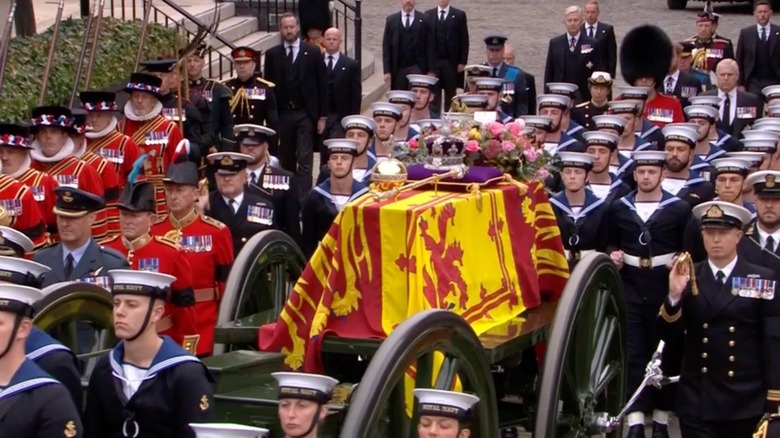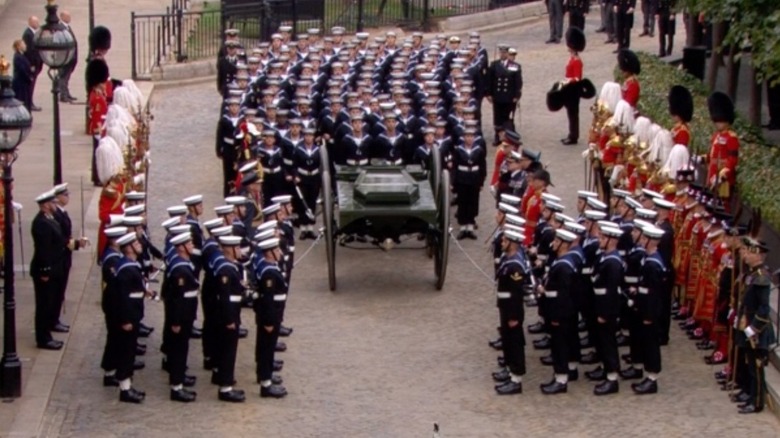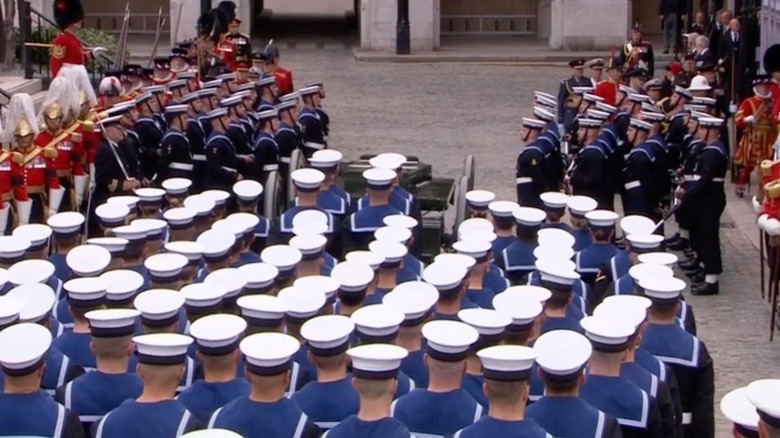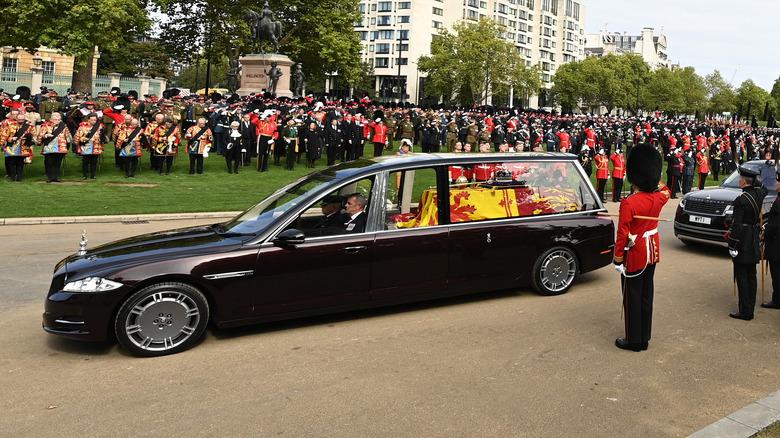Queen Elizabeth's Final Hearse Has Literally Zero Horsepower
The funeral of Queen Elizabeth II is underway, and as with several British monarchs before her, the monarch's coffin is being transported on a unique vehicle. Instead of a hearse, the queen's coffin was placed on a gun carriage and pulled to the country's main cathedral at around 10:44 am local time. The carriage itself is a unique part of British state funerals and has been part of the send-offs of several of the queen's predecessors and Winston Churchill — who was one of the few non-royals to have been given a state funeral.
Britain's longest-reigning figurehead, and the second-longest reigning monarch in recorded history, passed away on September 8, 2022, at the age of 96. Elizabeth II ascended to the throne in 1952 and spent her 70-year-long reign with the eyes of the world upon her. Her coronation, which took place in 1953, was the first to be fully televised, and her funeral is also set to become one of the most watched events in global history.
When the kind of carriage the queen's body was transported on had a cannon strapped to it, it would usually have been pulled by a pair of horses. However, due to the unique history of that particular carriage and the events preceding another famous British Queen's funeral, no horses are involved. Instead, personnel from the Royal Navy will be contributing to the precession by hauling Her Majesty's unique hearse through the streets of London.
The gun carriage has an interesting history
State funerals are diligently planned events, as they're thoroughly rehearsed and almost nothing is left to chance. This is why the organizers of Queen Victoria's funeral decided not to risk the carriage potentially toppling after the horses meant to pull the gun carriage were spooked. Instead, sailors from the Royal Navy stepped forward and used improvised ropes to pull the carriage (via the BBC).
The carriage was taken out of active service in 1901, the year of Queen Victoria's death and funeral. Since that time it has been in the care of The Royal Navy, and is officially referred to as the "State Gun Carriage," similar to how other official royal vehicles are named. Since then, it's been used in the funerals of King Edward VII, King George V, King George VI, Winston Churchill and Lord Louis Mountbatten. The carriage itself reportedly weighs 2,500 kilograms or around 2.5 imperial tons.
While Britain had more than its share of military endeavors in the early 1900s, the gun carriage used for state funerals never saw battle. It was originally built in 1896 and was modified before Queen Victoria's funeral. The modifications included a rubber coating for the wheels, and a raised platform being added to accommodate the royal coffin (via Town and Country).
How much horsepower could the carriage really have?
The 142 sailors pulling the gun carriage are split into two teams, with one team in front pulling the 2.5 ton vehicle forward and the other team following on behind and acting as a brake. Each team has a set of ropes that they pull in unison.
While no horses are involved, "horsepower" itself is a unit of measurement. According to the University of Calgary, an actual horse is capable of producing up to 15 horsepower. A human athlete can produce around 1.2 horsepower for a short length of time, and just under one horsepower for an extended period. So at an absolute maximum, assuming all of the sailors were pulling in the same direction, were in outstanding shape, and exerted themselves to the limits of their abilities, the gun carriage would have just over 170 horsepower. That's about the same amount as a 1.5 liter Chevy Equinox.
An actual hearse has been used too
As effective as the Royal Navy is, its sailors are still human. It would be pretty unreasonable to expect them to drag a gun carriage the 402 miles between Edinburgh, where the Queen was lying in state shortly after her death, to London, where the funeral proceedings took place, and then a further 23 miles to Windsor where she was laid to rest in St. George's Chapel. So, something more modern was needed. Two vehicles have been used to transport the queen's body so far. Initially, a black-clad Mercedes-Benz limousine was used, and more recently, the royal remains were transported in a modified Jaguar XF sedan that was altered to specifications set out by the late Queen herself.
The modifications included a raised roof and larger windows, to ensure the public get a better view of the royal coffin as the hearse passes. Visibility has also been enhanced by a glass roof, and three spotlights that have been added to the inside of the vehicle. The Queen isn't the first member of the royal household to have a hand in customizing their last ride. The monarch's late husband, Prince Philip, helped design the land rover hearse that was used following his death in 2021.



